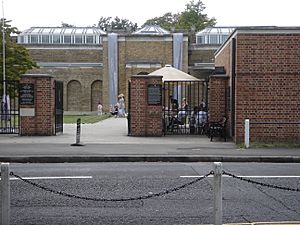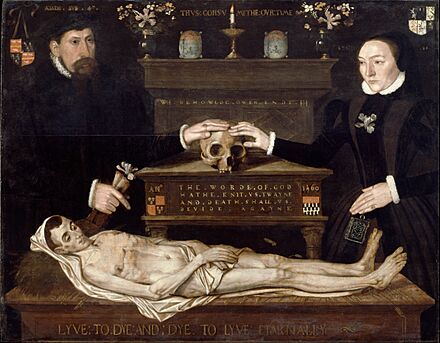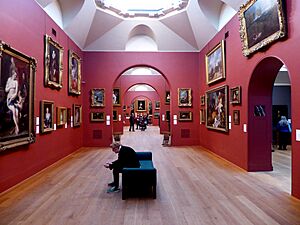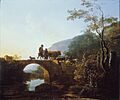Dulwich Picture Gallery facts for kids
 |
|
| Lua error in Module:Location_map at line 420: attempt to index field 'wikibase' (a nil value). | |
| Established | 1817 |
|---|---|
| Location | Dulwich London, SE21 England |
| Public transit access | |
The Dulwich Picture Gallery is a famous art gallery located in Dulwich, south London. It first opened its doors to the public in 1817. The gallery was designed by a talented architect named Sir John Soane during the Regency era. His design was special because of the clever way he used natural light to show off the artworks.
This gallery is the oldest public art gallery in England. In 1994, it became an independent charity. Before that, it was part of the College of God's Gift. This college was a charity started by the actor and businessman Edward Alleyn a long time ago. Thanks to gifts from its founders and many supporters, the Dulwich Picture Gallery has one of the best collections of Old Masters paintings in the country. It has many beautiful French, Italian, and Spanish Baroque paintings. It also has British portraits from the Tudor era up to the 1800s.
The Dulwich Picture Gallery and its special burial place, called a mausoleum, are listed as Grade II* buildings. This means they are very important historical buildings. The mausoleum is where the founders of the art collection, Francis Bourgeois and Noël Desenfans, are buried.
Contents
History of the Gallery
How the Gallery Started
Edward Alleyn (1566–1626) was a well-known actor in Elizabethan times. He also became a successful businessman. He owned parts of the Rose and Fortune Theatres, which were big rivals to the famous Globe Theatre. His wealth allowed him to buy the land of Dulwich in 1605. He then started a school there called the College of God's Gift. Next to the school, he built homes for poor people in the area.
Over time, the college grew into three separate schools: Dulwich College, Alleyn's School, and James Allen's Girls' School. These schools are still next to the gallery today. Edward Alleyn also gave the college a collection of paintings, including portraits of English kings and queens.
Later, in 1686, another actor named William Cartwright gave the college 239 pictures. About 80 of these paintings are still at Dulwich today. For a long time, the collection was shown on the first floor of the old college building. Not many new paintings were added during this period. Visitors sometimes felt disappointed by the collection. The writer Horace Walpole once said he saw "a hundred mouldy portraits."
The Founders: Bourgeois, Desenfans, and Sir John Soane
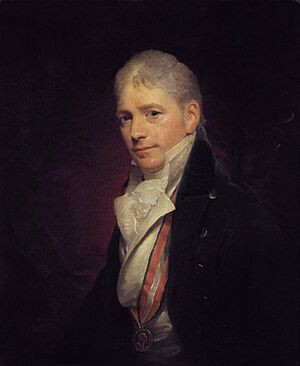
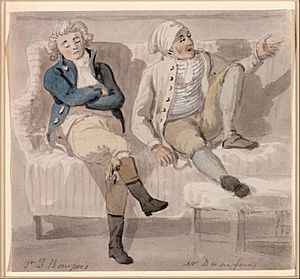
The Dulwich collection became much bigger and better thanks to Sir Francis Bourgeois (1753–1811) and his business partner, Noël Desenfans (1744–1807). They are seen as the true founders of the Dulwich Picture Gallery as we know it today. They ran an art business in London.
In 1790, the king of Poland asked them to gather a national art collection for his country. Bourgeois and Desenfans spent five years traveling around Europe buying fine art. However, by 1795, Poland had been divided up by other countries and no longer existed. This meant the collection had no home.
Bourgeois and Desenfans tried to sell the collection but couldn't. So, they sold some smaller pieces to buy other important artworks. They kept the main collection in Desenfans' house. When Desenfans passed away in 1807, Bourgeois inherited all the paintings.
Bourgeois asked Sir John Soane to design a mausoleum (a special building for burials) at Desenfans' house. But he couldn't get the land for it. On the advice of his friend, the actor John Philip Kemble, Bourgeois decided to give his art collection to the College of God's Gift.
In his will, Bourgeois asked for a gallery to be built in Dulwich to show the collection. He wanted Sir John Soane to design it. The gallery was built next to the original college buildings. Bourgeois left £2,000 for the building costs, and Desenfans' widow added another £4,000.
The gallery opened to students from the Royal Academy of Arts in 1815. It opened to the public two years later, in 1817. The delay was due to a problem with the heating system. The gallery became a popular place for art students to copy paintings. Many famous artists visited, including John Constable, William Etty, Joseph Mallord William Turner, and even Vincent van Gogh. The writer Charles Dickens also mentioned the gallery in his book The Pickwick Papers.
The Gallery in Modern Times
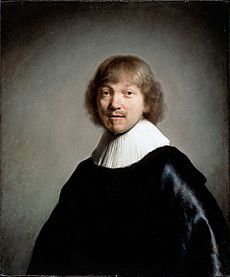
On December 31, 1966, eight paintings were stolen from the gallery. These included three by Rembrandt, three by Rubens, and one each by Gerrit Dou and Adam Elsheimer. The paintings were worth a lot of money. Luckily, all the paintings were found within a few days. Only one thief was caught and sent to prison.
Rembrandt's small painting, Portrait of Jacob de Gheyn III (1632), has been stolen and found four times! It is even in the Guinness World Records as the most stolen artwork in the world. The last time it was stolen was in 1983. It was found in Germany in 1986. Since 2010, the painting has had a much better security system. In November 2019, during a special exhibition, thieves tried to steal two more paintings, but they were not successful.
In 1995, the Dulwich Picture Gallery became an independent charity. This was part of a big change for the historic Alleyn's College charity.
In 2017, the gallery celebrated its 200th birthday. For this celebration, they worked with the London Festival of Architecture. They held a competition for new architects to design a temporary building called the 'Dulwich Pavilion'. This building was used for events in the gallery's gardens during the summer of 2017. A London architecture firm called IF_DO won the competition.
From June to September 2019, the gallery hosted a major exhibition of artworks from the Grosvenor School. This was the first time these works were shown in a public art gallery outside Australia. The exhibition was very popular.
The gallery reopened in May 2021 after being closed for 14 months due to the pandemic. They rearranged their collection and held a new exhibition called Unearthed: Photography’s Roots. In spring 2023, the gallery hosted the first major UK exhibition of the Impressionist artist Berthe Morisot since 1950.
Generous Donors
The gallery has received many gifts of art from generous people over the years. In 1835, William Linley gave his collection of family portraits to the gallery. These included paintings by famous artists like Thomas Gainsborough and Thomas Lawrence.
The portrait artist William Beechey gave a painting of the gallery's founder, Bourgeois, in 1836. This painting was actually on the back of another painting by Joshua Reynolds. So, the canvas has two pictures, but only one can be shown at a time.
British portrait art also became much stronger in the collection thanks to Charles Fairfax Murray. He was a painter, collector, and art dealer. He gave 40 pictures to the gallery in 1911, and more in 1915 and 1917–18.
Gallery Design
The design of the Dulwich Picture Gallery has influenced how art galleries are built around the world. Sir John Soane designed a series of connected rooms. These rooms are lit by natural light coming from skylights in the ceiling. Soane made sure the skylights lit the paintings indirectly.
Soane's design was very new for its time. Instead of using fancy white plaster and columns like many other architects, he used plain brick. This simple brick look was later copied by many art galleries in the 20th century. The architect Philip Johnson once said, "Soane has taught us how to display paintings."
Before deciding on the final design, Soane had other ideas. He thought about building a large square courtyard with the gallery as one side. But these plans were too big. Only the gallery was built, as one wing of a larger plan.
The idea for the mausoleum was also Soane's. Bourgeois had only said he wanted to be buried in the college chapel. Soane remembered Bourgeois' wish to build a mausoleum at Desenfans' home. So, he designed a similar one for the gallery. Bourgeois, Desenfans, and Desenfans' wife are all buried in the gallery's mausoleum.
Some small homes built by Soane next to the gallery were turned into exhibition spaces in 1880. An extension was also added between 1908 and 1938.
During World War II, on July 12, 1944, the mausoleum and some gallery wings were badly damaged by a German V1 flying bomb. The buildings were repaired and reopened by the Queen Mother in 1953.
In 1999, new parts were added, including a modern cafe, education rooms, and a lecture theatre. Parts of Soane's original design were also restored. Queen Elizabeth II officially opened the refurbished gallery in 2000.
In 2023, the gallery announced plans for a £4.9 million project. This will include a new sculpture garden and a new building for school and family activities.
Collection Highlights
The Dulwich Picture Gallery has an amazing collection of paintings from different art schools. Here are some of the artists and how many paintings by them are in the collection:
- Dutch School
- Aelbert Cuyp – 11 paintings
- Gerrit Dou – 1 painting
- Rembrandt – 3 paintings
- Jacob Isaakszoon van Ruisdael – 4 paintings
- English School
- Thomas Gainsborough – 7 paintings
- William Hogarth – 2 paintings
- Thomas Lawrence – 3 paintings
- Joshua Reynolds – 9 paintings
- John Constable – 1 painting
- Flemish School
- Peter Paul Rubens – 10 paintings
- David Teniers the Younger – 19 paintings
- Anthony van Dyck – 5 paintings
- French School
- Claude Lorrain – 4 paintings
- Nicolas Poussin – 6 paintings
- Claude-Joseph Vernet – 6 paintings
- Italian School
- Canaletto, (Giovanni Antonio Canal) – 2 paintings
- Annibale Carracci – 4 paintings
- Guercino, (Giovanni Francesco Barbieri) – 2 paintings
- Raphael, (Raffaello Sanzio) – 2 paintings
- Giovanni Battista Tiepolo – 3 paintings
- Spanish School
- Bartolomé Esteban Murillo – 4 paintings
Images for kids
Gallery Directors
Jennifer Scott became the Director of Dulwich Picture Gallery in April 2017. Before her, Ian A.C. Dejardin was the director from 2005. From 1996 to 2005, Desmond Shawe-Taylor was the Director. Giles Waterfield was the Director from 1979 to 1996.
See also
 In Spanish: Dulwich Picture Gallery para niños
In Spanish: Dulwich Picture Gallery para niños
- Dulwich OnView, a blog about the gallery
- Dulwich Outdoor Gallery, a gallery of street art
- Helen Hillyard, a curator


